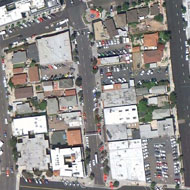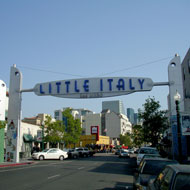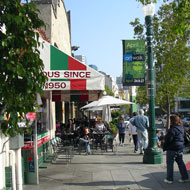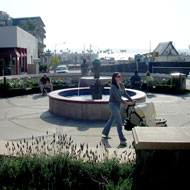San Diego, CA
Originally a predominately Italian fishing neighborhood, Little Italy is a thriving neighborhood in Downtown San Diego, California. The scenic neighborhood includes Italian restaurants, Italian retail shops, home design stores, art galleries and residential units.
A fairly easy walk, San Diego's Little Italy is over 48 square blocks filled with rich Italian culture, which allows visitors to absorb the people, sights and overall atmosphere. India Street, the thriving commercial corridor, runs straight through heart of Little Italy, intermingled with high-density mixed-use buildings and single-family bungalow-style historic properties. A trolley provides easy connection between Little Italy and the Santa Fe Train Depot, the American Plaza trolley transfer station and the Old Town Transit Center. Little Italy is located in close proximity to San Diego International Airport.
Historically, Little Italy was the home to Italian fishermen and their families. Many Italians moved to San Diego from San Francisco after the 1906 San Francisco earthquake in search of tuna and other deep-sea sport and commercial fish. When Interstate 5 was constructed through Little Italy in the early 1970s, 35% of the neighborhood was destroyed. During the same time, the California tuna industry was declining, which caused the neighborhood to suffer nearly 30 years of decline. At that time, the neighborhood was mainly composed of low-density commercial businesses and single-family detached homes.
With the creation of the Little Italy Association in 1996, the neighborhood has gone through gentrification and has seen a renaissance as a Community Benefit District. Its Italian food, boutique shopping and high level of street maintenance makes this shopping district the place to live in Downtown San Diego. Currently, the neighborhood is mainly composed of residential units – mostly mid-rises, high-rises and lofts – with ground floor retail stores and a few commercial buildings.
There are multiple public improvements and high-rise and mid-rise buildings under construction or scheduled for construction. Although many of the buildings have been renovated, the new buildings duplicate the same feel of the original establishments with huge archways, outdoor dining and ample vegetation that make visitors feel as though they have walked straight into Italy. During special events, many family-owned restaurants let visitors try their specialties. All along India Street, public art and various Piazzas invite visitors to stop and take in the San Diego sun.
Revitalization
Formation of a Business Improvement District (BID) during the 1990s, run by the private, nonprofit Little Italy Association, was a key factor in the area’s rebound. The association also runs a Community Benefit District (CBD). The Business Improvement District is funded through business tax licenses in the area and generates $90,000 a year. The Community Benefit District generates $750,000 a year through property assessments. The money from the BID and the CBD are used for maintenance and neighborhood security.
From eleven Italian-related businesses in the mid-1990s, Little Italy has grown to become home to 19 Italian restaurants, 22 home furnishing stores and 11 art galleries. The Centre City Development Corporation (CCDC) provided more than $4 million for many of the capital improvements to the streetscape. Improvements included upgrade and replacement of existing surfaces with particular sensitivity to retaining the original character along India Street, landscape, lighting and parking improvements as well as traffic circulation improvements and upgrades. The Little Italy Association provides maintenance funding for the trees, trashcans, landscaping and new sidewalks. The CCDC has also subsidized construction of 16 row houses, 12 affordable rental lofts and 37 low- and moderate-income apartments on a block of land the CCDC purchased. Currently the most common complaint is that an area once covered with parking lots is now one of the most difficult places to park in all of San Diego.
Adopted from: Shigley 2008
Other improvements have included:
- Revitalizing the C Street corridor from India Street to Park Boulevard to make it safer for pedestrians, more conducive to private development and business, and more efficient for trolley riders.
- Implementing the Trolley Renewal Project that focuses on repairing the nearly 30 year-old Blue and Orange lines, which are well beyond their life expectancy. The project includes installing low-floor trolleys, tracks and station platforms; replacing old rail and overhead wire; and improving switching, signaling and crossovers. The complete overhaul of transportation and pedestrian traffic flow is expected to be completed by 2015.
- Developing the Piazza Basilone at the southeast corner of Fir and India, which will transform half of Fir Street into the Piazza. The Piazza is strategically located at the bottom of Fir Street, allowing the street to be closed off for special events.
- Creating Amici Park, an approximately 50,000 square foot park in a formerly blighted corner of downtown bounded by Date Street and Interstate 5. The park is now shared by the community and Washington Elementary School.
- Establishing a parking district that allows meter fees to be retained to benefit parking projects in Little Italy. Over 20 years, this revenue is anticipated to be almost $2 million.
Community Events
Year-round community events are held in Little Italy, and the majority are related to Italian culture. Most of the events center on and around India Street, usually bordered by Grape Street to north and Beech Street or Ash Street to the south. Some of these include:
- Little Italy Mercato: An Italian farmers’ market held every Saturday on Date Street features freshly caught fish, vegetables and fruit from local farmers, pastries from local bakeries and art from Little Italy’s artists.
- Little Italy Carnevale: A Venetian mask event held before Mardi Gras with entertainment and an open house for retail shops and restaurants.
- ArtWalk: The largest art event on the west coast is held each April with over 120,000 people attending. It includes art, jewelry, furniture and more.
- Gran Fondo (Big Ride) Colnago San Diego: Over 3,000 bicycle riders from all over the world come to ride throughout “America’s Finest City” in a 32-, 53- or 100-mile ride that starts under the Little Italy’s landmark sign.
- Labor Day Stickball Tournament: Several stickball leagues come to play on the streets of Little Italy in this time-honored east coast game that is played like baseball. Every three years, the San Diego leagues host a West Coast Invitational where they invite New York and Puerto Rico to play on the streets of San Diego’s Little Italy.
- Little Italy Festa: The largest Italian festival outside of New York City occurs in Little Italy in October. It includes over 150 Italian food and craft booths, three stages of entertainment, the Gesso Italiano Street Painting Festival, a stickball exhibition game, bocce ball tournament, and beer and wine gardens.
- Little Italy Christmas Village and Tree Lighting: This holiday event occurs each December.
In addition, a number of food events, such as Festivale Siciliano and a Taste of Little Italy occur throughout the year.
The Italian Community Center of San Diego, a 500 member nonprofit organization founded in 1981 for people interested in Italian culture and language, also is located in the Little Italy neighborhood.
Lessons Learned
Potential Benefits:
- Leverages dedicated funding sources to implement improvements and provide maintenance.
- Builds on the neighborhood’s historic character.
- Utilizes mixed-use development to create a constituency for services.
- Expands pedestrian and social gathering spaces.
- Provides good linkage to transit.
- Hosts unique year-round events that are primarily tied to the neighborhood theme.
Potential Issues:
- Phased improvements: The neighborhood required improvements which were phased-in over several years.
- Community support: The support of businesses and the community is needed.
Sources
Blair, Tom, San Diego Magazine, (http://www.sandiegomagazine.com/media/San-Diego-Magazine/San-Diego-Covered/Local-Communities/San-Diego-County-Cities/Spicing-Up-Little-Italy/)
Cadelago, Christopher, December 22, 2010. “Little Italy Pushes for Park Expansion in Exchange for Loos” San Diego Union Tribune (http://www.signonsandiego.com/news/2010/dec/22/little-italy-pushes-park-expansion-exchange-loos/)
Centre City Development Corporation, August 11, 2005. “CCDC Breaks Ground On India Street Revitalization Project” (http://www.ccdc.com/media-and-publications/news/archived-news-2005/452-ccdc-news-9-11-05-ccdc-breaks-ground-on-india-street-revitalization-project.html)
Flores Lund Consultants (http://www.floreslund.com/projects_civil.htm)
Granite, Amy T. “Little Italy’s Evolution: San Diego’s Reigning ‘It’ Neighborhood Comes Into Its Own” 944 Media (http://www.944.com/articles/little-italy-s-evolution-san-diego-s-reigning-it-neighborhood-comes-into-its-own/)
Lamb, Mariko (http://sandiegonewsroom.com/news/index.php?option=com_content&view=article&id=42824:mariko-lamb-writing-for-sdnewscom&catid=191:downtown&Itemid=213)
Little Italy Association of San Diego “Piazza Basilone,” (http://www.littleitalysd.com/points-of-interest/piazza-basilone/)
Reed, David, Landscape Architects. “The Reconstruction of India Street – Little Italy, San Diego, California” (http://www.drasla.com/2008/08/india-street-little-italy/#more-19)
Shigley, Paul, October 29, 2008. “In Shadows Of Downtown, SD’s Little Italy Thrives Again” California Planning and Development Report (http://www.cp-dr.com/node/2169)
Wikipedia, “Little Italy, San Diego” (http://en.wikipedia.org/wiki/Little_Italy,_San_Diego)
Photo Sources
MIG, Inc.




